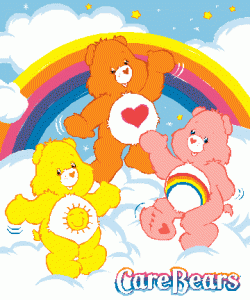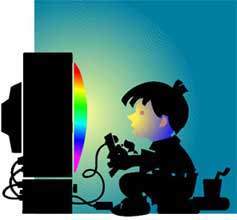Care Bears: “The Camp-Out”
 Similar to other program-length commercials (PLCs), the Care Bears began as characters on greeting cards in 1981. The Care Bears were depicted by plush animals in 1983, and ultimately landed their own television show by 1985. Examining an episode of the Care Bears television series entitled “The Camp-Out,” it is immediately obvious from the initial theme song that this series is a feel-good series intending to reach out to the imaginative child.
Similar to other program-length commercials (PLCs), the Care Bears began as characters on greeting cards in 1981. The Care Bears were depicted by plush animals in 1983, and ultimately landed their own television show by 1985. Examining an episode of the Care Bears television series entitled “The Camp-Out,” it is immediately obvious from the initial theme song that this series is a feel-good series intending to reach out to the imaginative child.
In this episode, a group of Care Bears go on a camping trip to a friendly looking forest. Care Bears Playful Heart and Funshine Bear call for help with the intention of tricking Brave Heart and the other adult-like Care Bears. After scolding Playful Heart and Funshine Bear about the consequences that could result from calling for help when they do not need it, Brave Heart proceeds to tell a scary story of the Swamp Monster. Playful Heart and Funshine Bear take this story as an invitation to scare the rest of the Care Bears by dressing up as the Swamp Monster later in the evening. Throughout the episode shadows of the real Swamp Monster are seen. The following morning Playful Heart and Funshine Bear again trick the other Care Bears by calling for help. The rest of the group does not find this very amusing. When Playful Heart and Funshine Bear are really in trouble and call for help, none of the others respond, aside from the two Care Bear cubs, Hugs and Tugs. When the Swamp Monster ends up being the series regular villain, Mr. Beastly, confusion about the real Swamp Monster breaks out amongst the adult Care Bears. Eventually the real Swamp Monster reveals himself to be a gentle and shy creature that cares and looks out for the forest and its inhabitants. The Swamp Monster rescues the cubs, Playful Heart and Funshine Bear. In the end, Playful Heart and Funshine Bear learn that playing tricks on their friends can end poorly, and their friends might not be there when they really need them.
The above summarized episode will act as an example of a typical Care Bears episode. Using this assumption, the Care Bears series abides by Cross’ idea of PLCs as “fantasy worlds.” However, the fantasy world created in the series does not perpetuate the fatalistic view that Cross would suggest. The Care Bears are living in a fantasy world, but the program attempts to teach lessons that are applicable to the real world of a child. For a child, learning the lesson of not calling out for help when you do not need it, and not playing tricks on your friends has a very real application. This lesson comes in a brief fifteen minute package that indulges the child in a fantasy world that is “free from adults” (290). It could be speculated that the child would actually respond better to an informal lesson from imaginary characters that it feels personally connected to, rather than in a formal lesson from an adult. The purposeful lessons in the Care Bears episodes serve as an antithesis for Cross’ idea that “the old view that children should learn from the past and prepare for the future” has disappeared into consumer culture (290). The Care Bears’ lessons serve to prepare children for the future. Fortunately for the child, preparation for the future does not come in a dry, dusty fashion, rather a colorful, indulgent fantasy world.
The video of “The Camp-Out” can be found at: http://www.youtube.com/watch?v=2FKx0sIF8cw&feature=sh_e_se&list=SL
(embedding for this video was disabled.)





